The kitchen sink is a central element of the kitchen, and as an indispensable piece of kitchen furniture, its importance cannot be overstated. However, many homeowners’ knowledge of kitchen sinks is limited to basic concepts such as large single sinks and undermount basins, which are just the tip of the iceberg when it comes to picking out a suitable product. This kitchen sink guide will explain in detail the purchase and installation skills of the sink, to help you easily select the ideal sink.
First, the kitchen sink guide: how to buy a sink
The purchase of the sink is a key part of the kitchen decoration. Don’t look at it as just a small piece of furniture, there are a lot of skills when choosing. The following six points of purchase to help you easily pick a satisfactory sink.
Avoid DUS304 stainless steel sinks
The edge of the sink is usually marked with material information. Since the sink is a piece of furniture in direct contact with food, the choice of material is crucial and directly related to health issues. The best choice is 304 stainless steel or even better 316 stainless steel.
There are so many different types of stainless steel that you may be confused when you see the different labelling. In fact, SUS and DUS are stainless steel, but their synthetic elements are different.DUS304 stainless steel contains chromium, manganese, sulphur, phosphorus and other elements, corrosion resistance is poor, easy to rust in the process of use, but also precipitate manganese elements harmful to the human body.
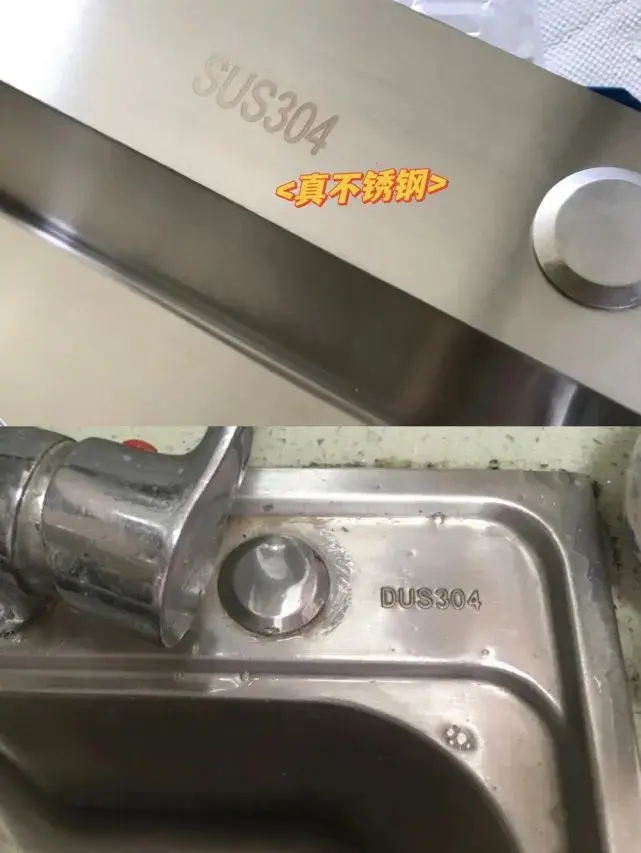
SUS304 is the real food grade stainless steel, better corrosion resistance, fully meet the food contact requirements. For homeowners who don’t know how to identify the real thing, you can use a stainless steel tester to test it. This tester is readily available online and is very inexpensive. Simply apply a few drops and wait for about 3 minutes, those that do not change colour are real stainless steel and those that do are shoddy products.
When choosing a sink, do not be greedy for cheap. Recognition of SUS304 stainless steel sink, it is best to choose the price of about $ 1,000 brand products, the quality is more guaranteed. For hundreds of dollars of large single sink, it is recommended to choose carefully.
Choose carefully black sink
Although black has the advantage of dirt resistance, but the premise is not to encounter limescale. For daily home use of water-related appliances, black is not a good choice, otherwise you will suffer from limescale.
For example, the sink in this homeowner’s house, which is predominantly black in colour, is covered in hard-to-clean limescale on the bottom and sides of the basin. Unless you use a water purifier to improve the quality of the water, limescale is produced when tap water is heated.
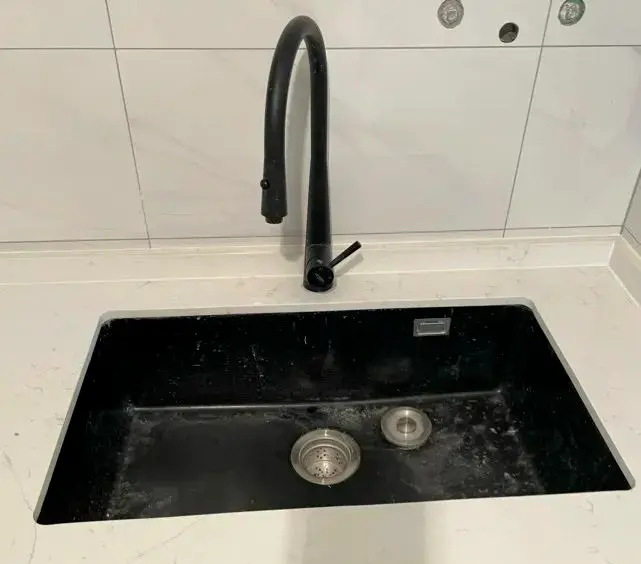
A silver sink, on the other hand, has no such worries. It is neither too white to resist staining nor too dark in colour to be affected by limescale. For lazy people, choosing a silver sink can save a lot of housework.
Choose the right depth of the sink
The depth of the sink is also a key consideration in the selection. The depth of the sink is too shallow, easy to splash out when washing dishes; while the depth of the sink is too deep, you need to bend over at a large angle, easy to feel fatigue when washing vegetables and dishes.
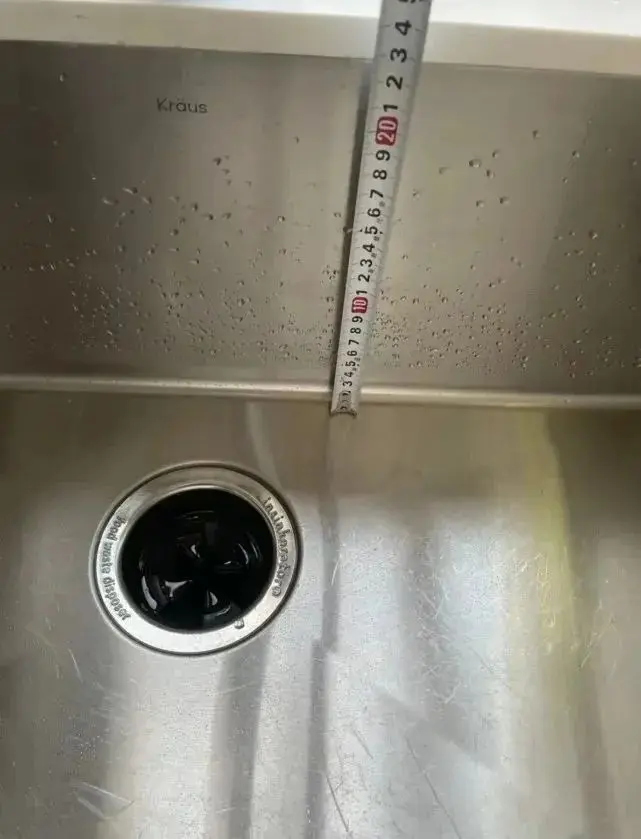
It is recommended to choose a sink with a depth of between 20-25cm. Such a depth can prevent splashing, but also to avoid bending over a large angle, to improve the comfort of use.
Focus on the thickness of the sink
The thickness of the sink directly determines its quality. The thickness mentioned here refers to the thickness of the body of the sink, mainly measured at the mouth of the sink, rather than the thickness of the edge of the sink. In general, the edge of the sink in order to increase the load-bearing and avoid deformation, the thickness of the outer frame can be up to 3 mm.
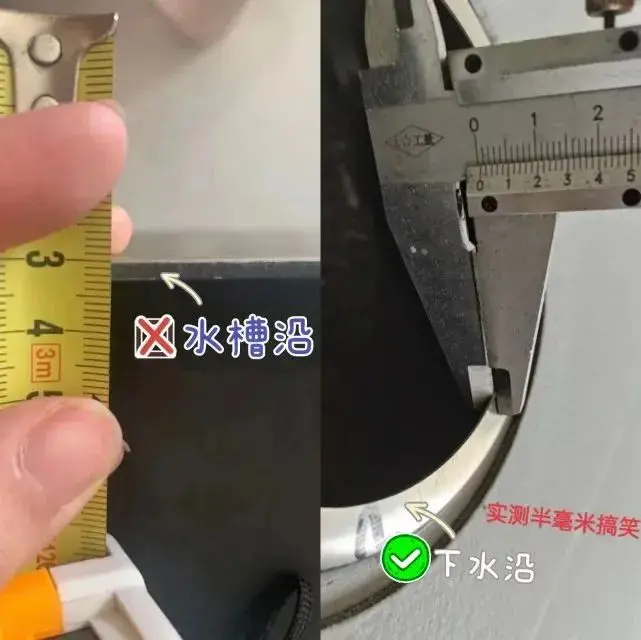
Theoretically, the greater the thickness of the body, the better the durability of the sink. During the purchase process, you should actually measure the thickness at the spout and ask the merchant about the parameters here. In fact, the thickness of the basin has a lot to do with the manufacturing process. The sink process on the market is mainly divided into two categories of hand-welded and one-piece stamping and moulding.
Hand-welded sinks, the corner of the R angle is smaller, the space utilisation is higher, the basin thickness is also larger. But welding is not good may leak. One-piece stamping moulding sink, basin bottom R angle is larger, semi-circular shape, space utilisation is not high. And the stamping process will destroy the originality of stainless steel, so the thickness is often less than 1 mm.
Therefore, you can choose a sink by looking at the size of the R-corner. a product with a small R-corner usually means that it is hand-welded, thicker and more durable. It is important to note that sinks are not rock slab one-piece basins and there is no such thing as a right angle to the bottom of the basin. Many people simply mistake the small R-corner for a right angle.
Avoiding sinks with centre drains
The location of the sink has an impact on its use. The centre of the sink means that the space under the basin is not good use, there is a suspicion of wasted space. And back or by the side of the sink, the location of the downpipe will be corresponding back or by the side, the basin under the space better use.
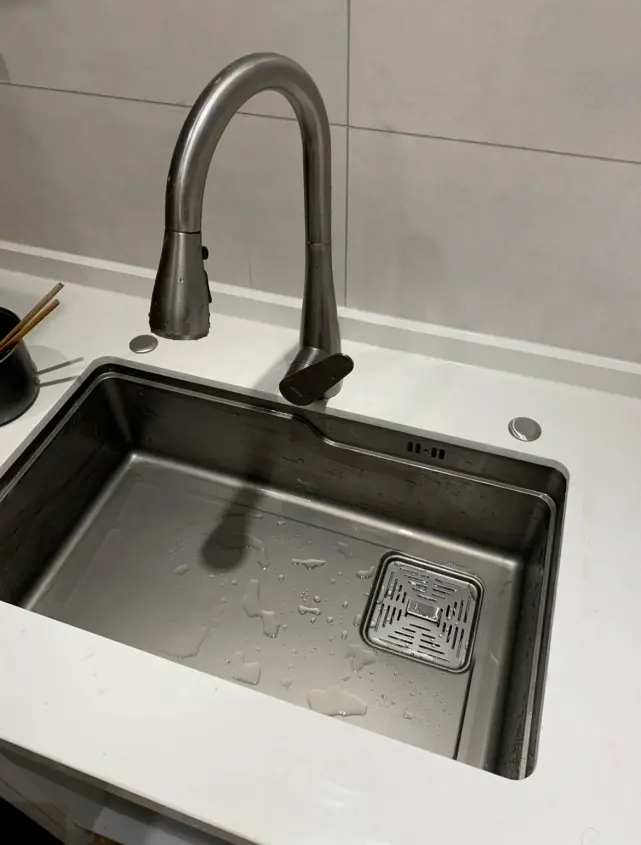
It is best to choose U-type side drain. This drain can not only save space under the basin, but also comes with a backflow valve, effectively avoiding small insects and odours.
Avoid choosing the chicken ribs configuration of the sink
Nowadays, there are many configurations of sinks, basin periphery, common knife rack, cup washer, fly rain and so on. These configurations seem advanced, but in fact the practicality is not strong.
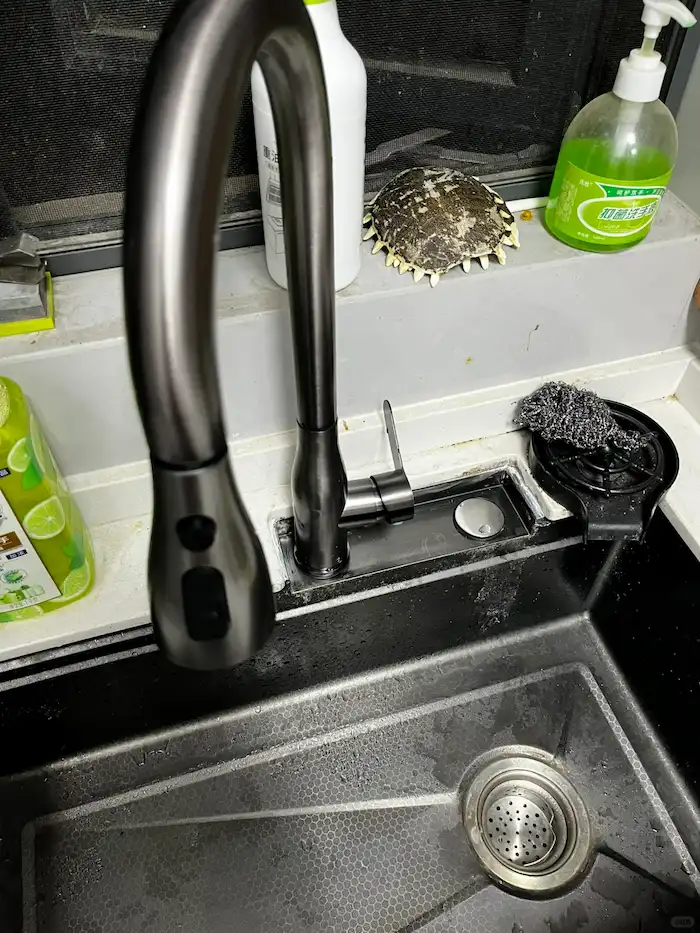
In particular, the fly rain and cup washer, due to the complex shape, easy to hide dirt, and very difficult to clean. The holes in the spout of the Flying Rain waterfall are very small, and limescale will build up over time, creating the same problem as the shower. It is recommended that you choose a model with a simple configuration to avoid cluttering the countertop and reduce cleaning hassles, and at a lower price, it is more cost-effective.
In addition to this, check that the basin slab has a sound deadening mat. This rectangular soft cushion affixed to the side of the sink can effectively reduce the ticking sound made by the water flow hitting the sink wall. Also, the sink floor will have an anti-condensation coating applied to the entire back of the sink, which has a somewhat grey texture to the touch and serves to prevent condensation from beading. Without this coating of the sink, in cold water, hot water alternately, the sink wall will form condensation beads, resulting in cabinet cabinet interior moisture, mould.
Second, the kitchen sink guide: how to install the sink
Selected a good sink, the next step is to install it. Choose a good, well installed is really qualified. This kitchen sink guide will introduce you to the installation skills of the sink.
Countertop installation
Countertop sink installation is the most traditional installation. Early sinks were almost always countertop basins with the rim of the basin above the countertop. So that the water and rubbish on the countertop can not be swept directly into the basin, and the basin rim gap is also easy to mould and black.
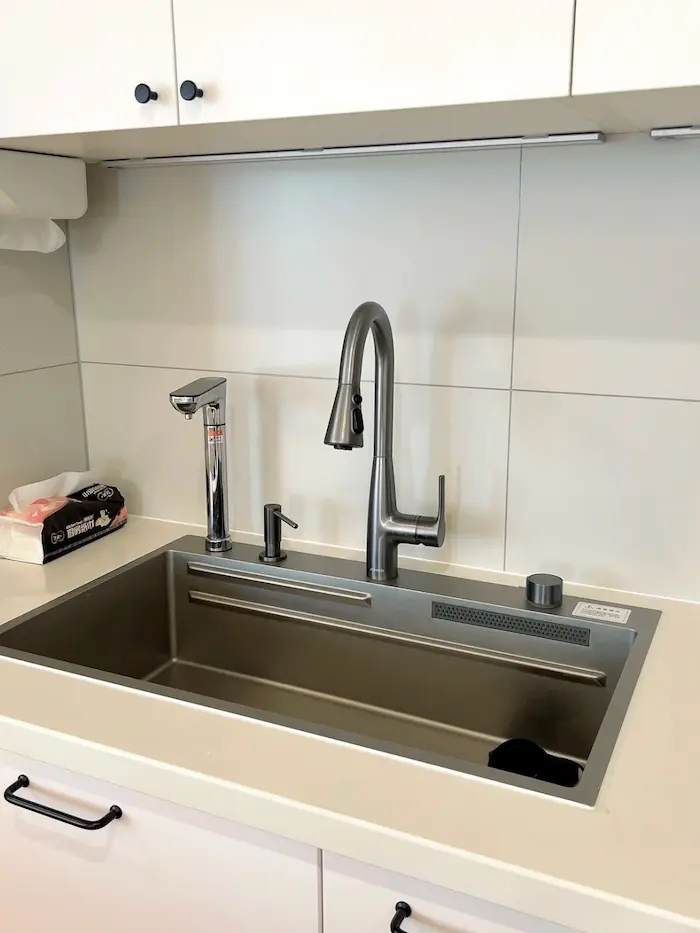
Its biggest advantage is good load-bearing performance, using the countertop support. But the shortcomings are also obvious, has been gradually eliminated.
Installation of pedestal washbasin
The pedestal basin is an improved version of the countertop basin. It removes the thickness of the rim of the basin by polishing the countertop, so that the basin and the countertop are flush. This installation improves the problem that water and rubbish on the countertop cannot be swept into the basin.
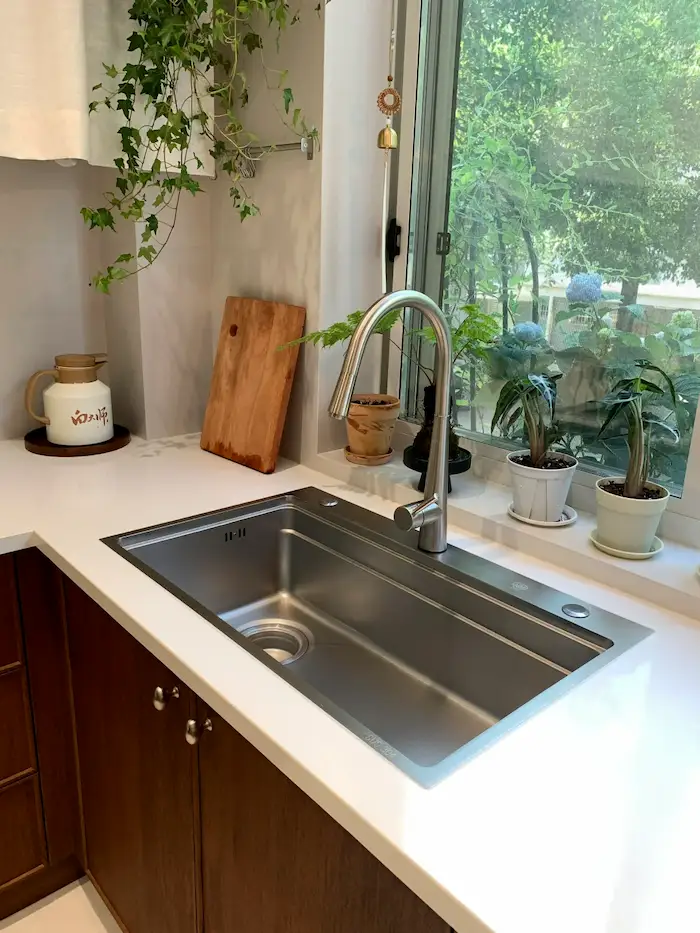
However, there are still four visible gaps around the basin perimeter, which can become mouldy and black over time.
Undercounter basin installation
Undercounter basin installation is by far the most common installation method. Basin edge is fixed under the countertop, the countertop will not reveal the basin edge, more convenient for daily cleaning, and there is no mould and black trouble. However, it has higher installation requirements, otherwise the load-bearing capacity is general.
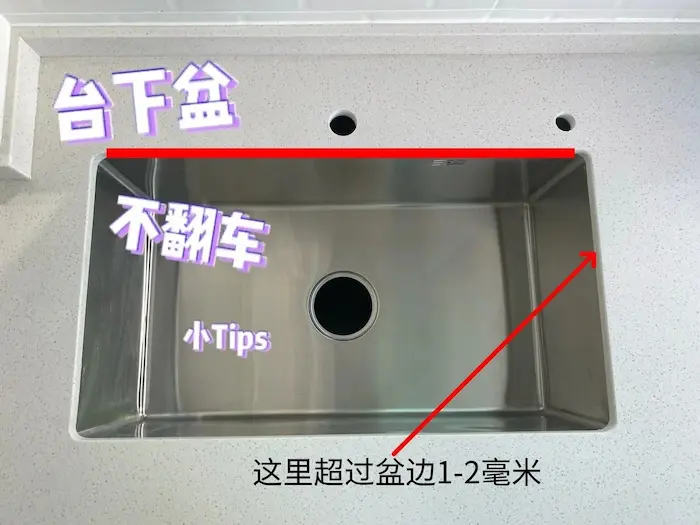
In the current market, many installers are using glue to fix the way to install the undercounter basin. If the glue is aging, the probability of the washbasin falling is extremely high, which is a very non-recommended method.
The best way to install an undercounter basin is to fix the basin between the liner and the countertop. The liner plays the role of support, the countertop plays the role of cover, without glue fixed, load-bearing capacity and stability but better. As in the picture, the liner is made of quartzite for better support.
In order to ensure that the undercounter basin is more stable after installation, it is recommended that the liner at the washbasin choose quartz stone material. When the countertop is cut, it is best to have the countertop over the rim of the washbasin to create a hidden effect and make it more comfortable to use. Of the three ways to install a washbasin, undercounter basin installation is the best practice. If you are concerned about the basin falling off, you can also choose a pedestal basin.
Which installation option did you choose for your family’s washbasin? Hopefully, this kitchen sink guide can provide you with some useful references and assistance.

